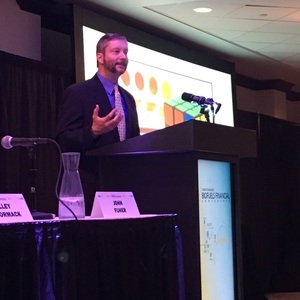Final BFC panel looks to the future

Lisa Gibson
September 28, 2017
BY Lisa Gibson
When Congress can’t agree, bills die, said Jamey Cline, business development director for Christianson PLLP, to his audience at the Biofuels Financial Conference Sept. 28 in Minneapolis. Cline presented about the immediate future of grant opportunities during the final panel of the event, themed “Biofuelture.”
“In certain cases, some grants and incentives might lower your cost and provide some comfort for your board of directors,” he said, specifically citing the Rural Energy for America Program, funded at $50 million annually through the Farm Bill. The program provides grants for renewable energy and energy efficiency projects for rural small business and agricultural producers.
But the Farm Bill, along with many incentives and funding opportunities in the biofuels sector, is up in the air. Trump’s budget proposal in April included a 21 percent cut from the U.S. Department of Agriculture’s budget. Another, more recent senate proposal suggested a 38 percent increase in farm bill funding, Cline cited. The disagreements prompt significant uncertainty.
Advertisement
“When’s the best time to ask for something? During an election,” Cline said.
Risk for future funding is significant, but Christianson’s experience helps it find funding for its clients, even when it’s difficult, Cline says.
He outlined main challenges in grant funding, starting with, “Don’t wait. We recommend starting well before construction starts.” He also pointed out that requirements differ from state to state and can change in the middle of grant cycles; state personnel often are unfamiliar with biofuels; grants for renewables are generally larger than grants in other sectors, which means they’re more heavily scrutinized; grants are competitive; and some are pro-rated.
Panelist John Fuher, senior director of government affairs for Growth Energy, discussed the immediate future of legislation, highlighting the RIN market, the Renewable Fuel Standard and Reid vapor pressure challenges for E15. “That has a dramatic impact,” Fuher said. “When you can’t sell a fuel for three months out of the year, that makes it difficult to build a market.”
Advertisement
Christianson’s Biofuels Financial Conference was held Sept. 27 and 28 at the Radisson Blu in Minneapolis. BBI International, which publishes Ethanol Producer Magazine, partnered with Christianson to hold the event.
Related Stories
The U.S. Energy Information Administration maintained its forecast for 2025 and 2026 biodiesel, renewable diesel and sustainable aviation fuel (SAF) production in its latest Short-Term Energy Outlook, released July 8.
XCF Global Inc. on July 10 shared its strategic plan to invest close to $1 billion in developing a network of SAF production facilities, expanding its U.S. footprint, and advancing its international growth strategy.
U.S. fuel ethanol capacity fell slightly in April, while biodiesel and renewable diesel capacity held steady, according to data released by the U.S. EIA on June 30. Feedstock consumption was down when compared to the previous month.
XCF Global Inc. on July 8 provided a production update on its flagship New Rise Reno facility, underscoring that the plant has successfully produced SAF, renewable diesel, and renewable naphtha during its initial ramp-up.
The U.S. EPA on July 8 hosted virtual public hearing to gather input on the agency’s recently released proposed rule to set 2026 and 2027 RFS RVOs. Members of the biofuel industry were among those to offer testimony during the event.
Upcoming Events










